
Nepeta is a genus of flowering plants in the family Lamiaceae. The genus name, from Latin nepeta (“catnip”), is reportedly in reference to Nepete, an ancient Etruscan city. There are 295 accepted species.
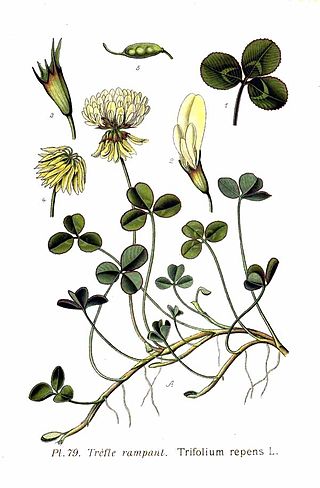
Clover, also called trefoil, are plants of the genus Trifolium, consisting of about 300 species of flowering plants in the legume family Fabaceae originating in Europe. The genus has a cosmopolitan distribution with highest diversity in the temperate Northern Hemisphere, but many species also occur in South America and Africa, including at high altitudes on mountains in the tropics. They are small annual, biennial, or short-lived perennial herbaceous plants, typically growing up to 30 centimetres (12 in) tall. The leaves are trifoliate, with stipules adnate to the leaf-stalk, and heads or dense spikes of small red, purple, white, or yellow flowers; the small, few-seeded pods are enclosed in the calyx. Other closely related genera often called clovers include Melilotus and Medicago.

Medicago is a genus of flowering plants, commonly known as medick or burclover, in the legume family (Fabaceae). It contains at least 87 species and is distributed mainly around the Mediterranean Basin, and extending across temperate Eurasia and sub-Saharan Africa. The best-known member of the genus is alfalfa, an important forage crop, and the genus name is based on the Latin name for that plant, medica, from Greek: μηδική (πόα) Median (grass). Most members of the genus are low, creeping herbs, resembling clover, but with burs. However, alfalfa grows to a height of 1 meter, and tree medick is a shrub. Members of the genus are known to produce bioactive compounds such as medicarpin and medicagenic acid. Chromosome numbers in Medicago range from 2n = 14 to 48.

Honeysuckles are arching shrubs or twining vines in the genus Lonicera of the family Caprifoliaceae. It includes 158 species native to northern latitudes in North America, Eurasia, and North Africa. Widely known species include Lonicera periclymenum, Lonicera japonica and Lonicera sempervirens. L. japonica is a highly invasive species considered a significant pest in parts of North America, Europe, South America, Australia, and Africa.
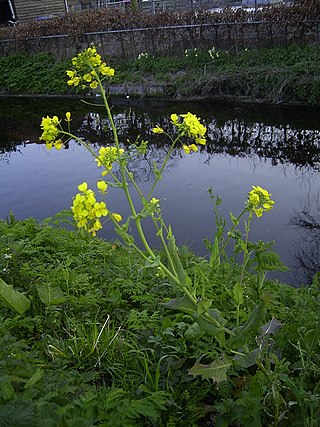
Brassica is a genus of plants in the cabbage and mustard family (Brassicaceae). The members of the genus are informally known as cruciferous vegetables, cabbages, mustard plants, or simply brassicas. Crops from this genus are sometimes called cole crops—derived from the Latin caulis, denoting the stem or stalk of a plant.
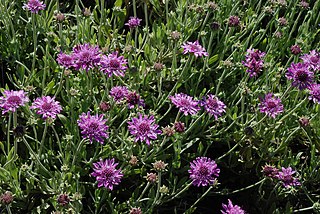
Pterocephalus is a genus of flowering plants in the family Caprifoliaceae. It comprises 34 species of herbs and shrubs ranging from the Mediterranean to central Asia, the Himalayas, and tropical Africa.

Alcea is a genus of over 80 species of flowering plants in the mallow family Malvaceae, commonly known as the hollyhocks. They are native to Asia and Europe. The single species of hollyhock from the Americas, the streambank wild hollyhock, belongs to a different genus.

Plumbaginaceae is a family of flowering plants, with a cosmopolitan distribution. The family is sometimes referred to as the leadwort family or the plumbago family.
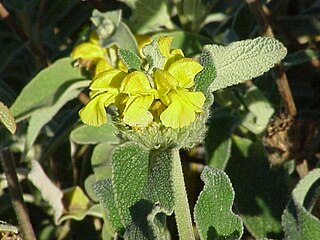
Phlomis is a genus of over 100 species of herbaceous plants, subshrubs and shrubs in the mint family Lamiaceae, native from the Mediterranean region east across central Asia to China.

Rhamnus is a genus of about 140 accepted species of shrubs or small trees, commonly known as buckthorns, in the family Rhamnaceae. Its species range from 1 to 10 m tall and are native mainly in east Asia and North America, but found throughout the temperate and subtropical Northern Hemisphere, and also more locally in the subtropical Southern Hemisphere in parts of Africa and South America. One species, the common buckthorn, is able to flourish as an invasive plant in parts of Canada and the U.S., where it has become naturalized.
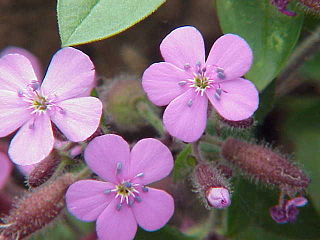
Saponaria is a genus of flowering plants in the family Caryophyllaceae, native to Asia and Europe, and are commonly known as soapworts. They are herbaceous perennials and annuals, some with woody bases. The flowers are abundant, five-petalled and usually in shades of pink or white. The genus is closely related to the genus Silene, being distinguished from these by having only two styles in the flower. It is also related to Gypsophila, but its calyx is cylindrical rather than bell-shaped.

Bellevalia is a genus of plants in the family Asparagaceae, subfamily Scilloideae. It was first described as a genus in 1808.

Petrorhagia is a small genus of annual and perennial plants of the family Caryophyllaceae, mostly native to the Mediterranean region. It is low-growing with wiry stems and narrow, grass-like leaves. The flowers are small, in clusters similar to members of the genus Dianthus, in pink, lilac, or white. Petrorhagia saxifraga is the tunic flower or coat flower, similar to baby's breath, but shorter, and used in rock gardens.

Arenaria is a genus of flowering plants, within the family Caryophyllaceae.

The Cardueae are a tribe of flowering plants in the daisy family (Asteraceae) and the subfamily Carduoideae. Most of them are commonly known as thistles; four of the best known genera are Carduus, Cynara, Cirsium, and Onopordum.

Rocket, eruca, or arugula is an edible annual plant in the family Brassicaceae used as a leaf vegetable for its fresh, tart, bitter, and peppery flavor. Its other common names include garden rocket, as well as colewort, roquette, ruchetta, rucola, rucoli, and rugula.

Jurinea is a genus of plants in the family Asteraceae.

Haloxylon is a genus of shrubs or small trees, belonging to the plant family Amaranthaceae. Haloxylon and its species are known by the common name saxaul. "Saksaul" is a common Turkic word that entered Russian through Kazakh.

Acer heldreichii is a species of maple in the flowering plant family Sapindaceae. Commonly called Balkan maple, Greek maple, Heldreich's maple, or mountain maple the species is native to the Balkan Peninsula east along the southern and eastern coasts of the Black Sea.

Cota is a genus belonging to the chamomile tribe within the sunflower family. It is native to Europe, North Africa, and southwestern Asia, with a few species naturalized elsewhere. It is an herbaceous plant with flower heads including white or yellow ray florets and yellow disc florets.



















